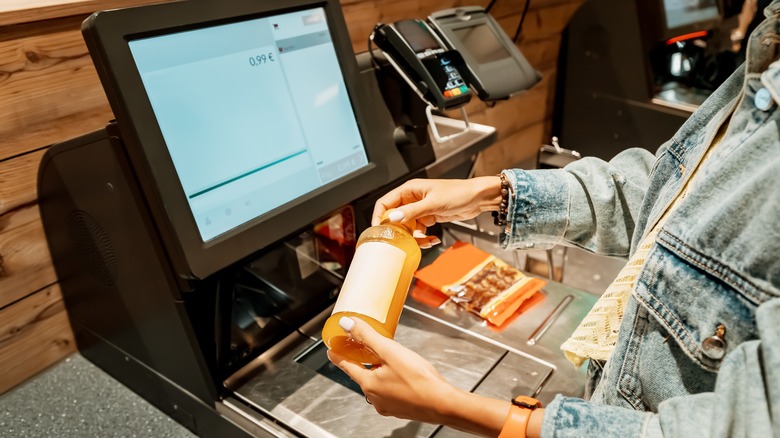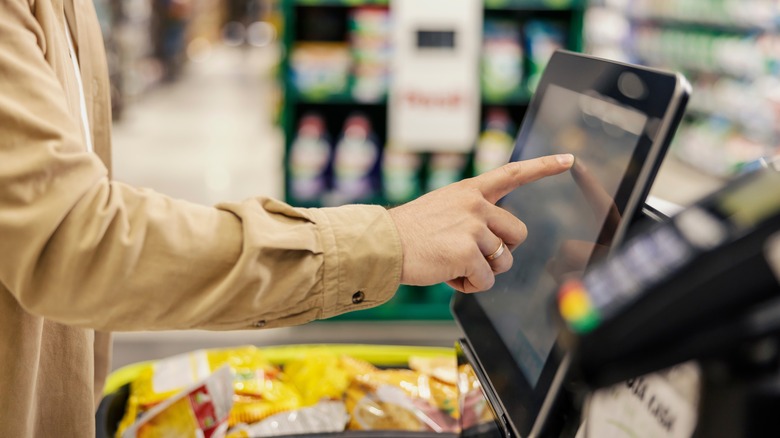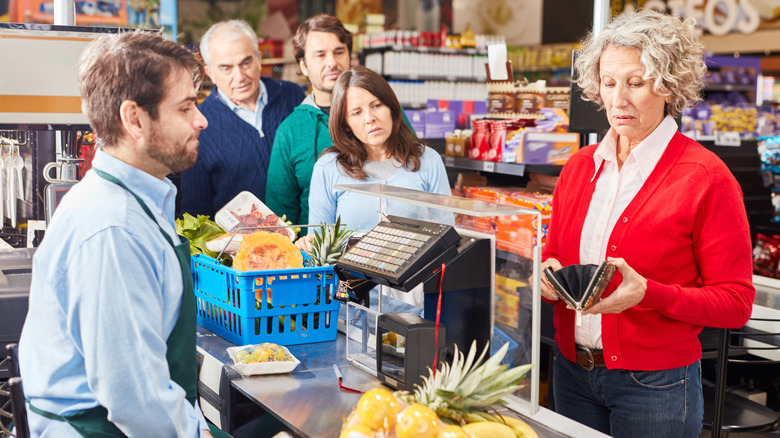Why Grocery Store Express Lanes Aren't Always Faster
Since the invention of the self-checkout kiosk in 1992, express lanes that use these unique machines have been touted as a faster way to get in and out of the grocery store. However, as most shoppers know, express lanes aren't always necessarily speedier than the standard cashier lanes, largely due to the behavior of shoppers themselves.
Despite many express lanes having a posted item limit of 20 or lower, only about 7% of shoppers actually follow this particular aspect of grocery store self-checkout etiquette, according to a study published by the National Library of Medicine. The other 93% go over the limit, whether that's by a single item or by several dozen. Of course, as harmless as this may seem in the moment, going over the item limit can quickly back up the flow of shoppers throughout the self-checkout section. After all, the more items we have personally scan and bag, the longer it's going to take.
To make matters worse, express lanes are typically more popular than cashier lanes, as we all have this idea that it's faster to just check ourselves out. As such, there are more people in the express lane line to begin with, and once you tack on the fact that many shoppers are well over the item limit, everyone's going to pay the price where time is concerned.
Most shoppers aren't pros in the express lane
No matter how many times we've been grocery shopping, we're all still going to make mistakes and run into problems. When it comes to using express lanes, however, those problems increase exponentially because we're trying to successfully scan and pay for every item ourselves –- and we don't always have the skills or knowledge to do so.
For instance, many shoppers bring lots of produce to self-checkout, only to struggle with finding the item's code or getting tiny barcodes to scan. Others bring booze to self-checkout, slowing down the entire system when they have to wait for an employee to come over and check their ID and approve the purchase. Coupons that won't scan, missing barcodes, accidental double-scans, scale issues, and damaged products can also force shoppers to flag down an employee, costing everyone time.
Needless to say, most (if not all) of these problems could be solved by shoppers knowing when to choose a cashier lane over the express lane. We can't anticipate all problems that may arise, but we can do our best when we know there are age-restricted or security-tagged items in our basket — as well as how confident we are in manipulating the often-finicky self-checkout machines.
How to get through grocery store checkout in the least amount of time
While we may not be able to control the actions of other shoppers, we can take note of our surroundings to get through grocery store checkout a lot more quickly. For starters, if you have more than a few items, skip the express lane and instead choose the cashier lane farthest to the left, as most people will instinctively gravitate to the right.
Another good rule of thumb is to choose a line with fewer shoppers and more items, rather than a line with more shoppers and fewer items (like most express lanes). Though this seems contradictory, fewer shoppers in line means fewer transactions to process and fewer carts to reload.
That being said, consider scoping out the items in other shoppers' carts before choosing a lane. If someone has alcohol, their purchase will need ID verification, while a basket full of produce will require a lot of manual code-entering. Likewise, if someone has large items in their cart that may necessitate the cashier coming around the counter to scan them, additional time will be tacked on. With these tips, you've got your next speedy shopping trip in the bag.



